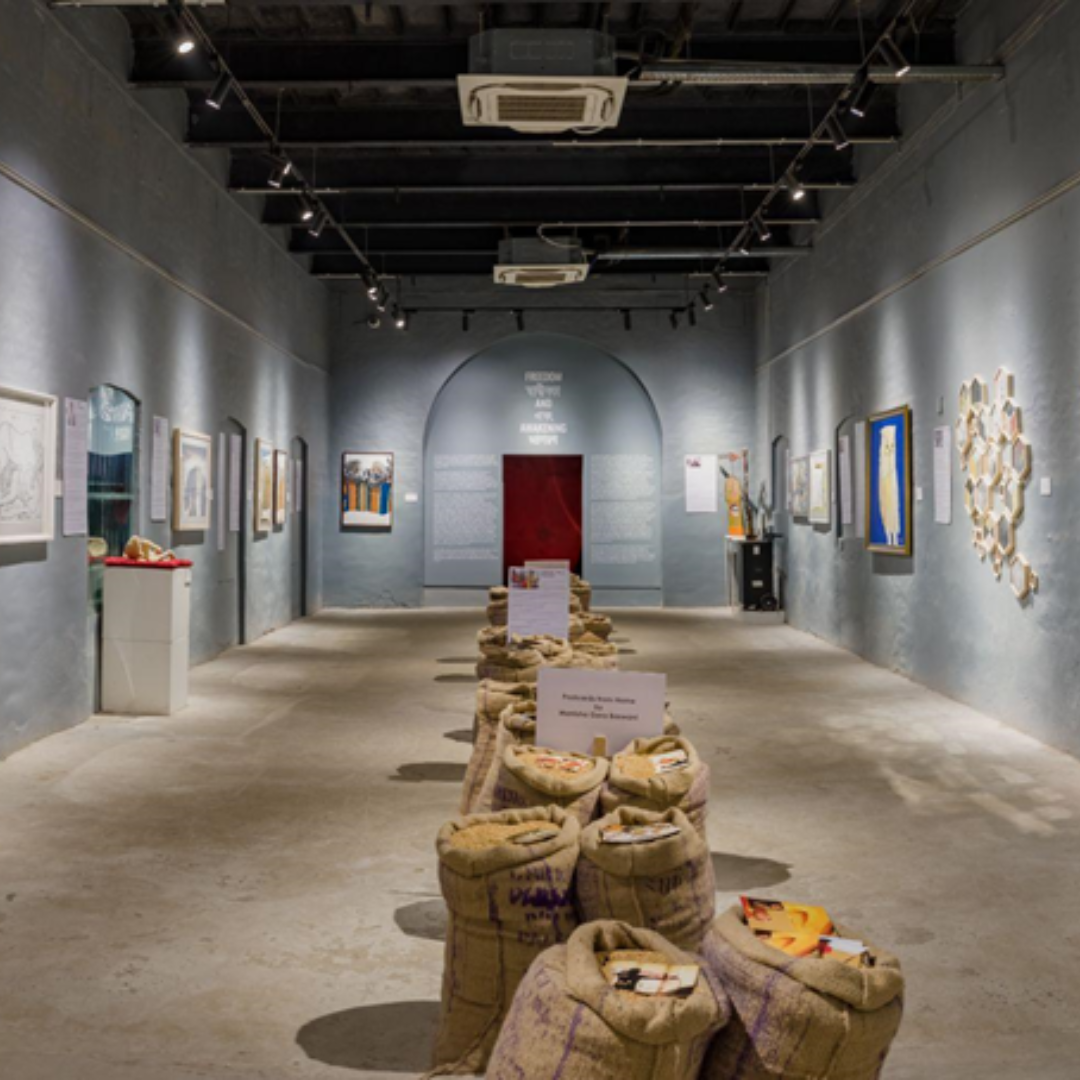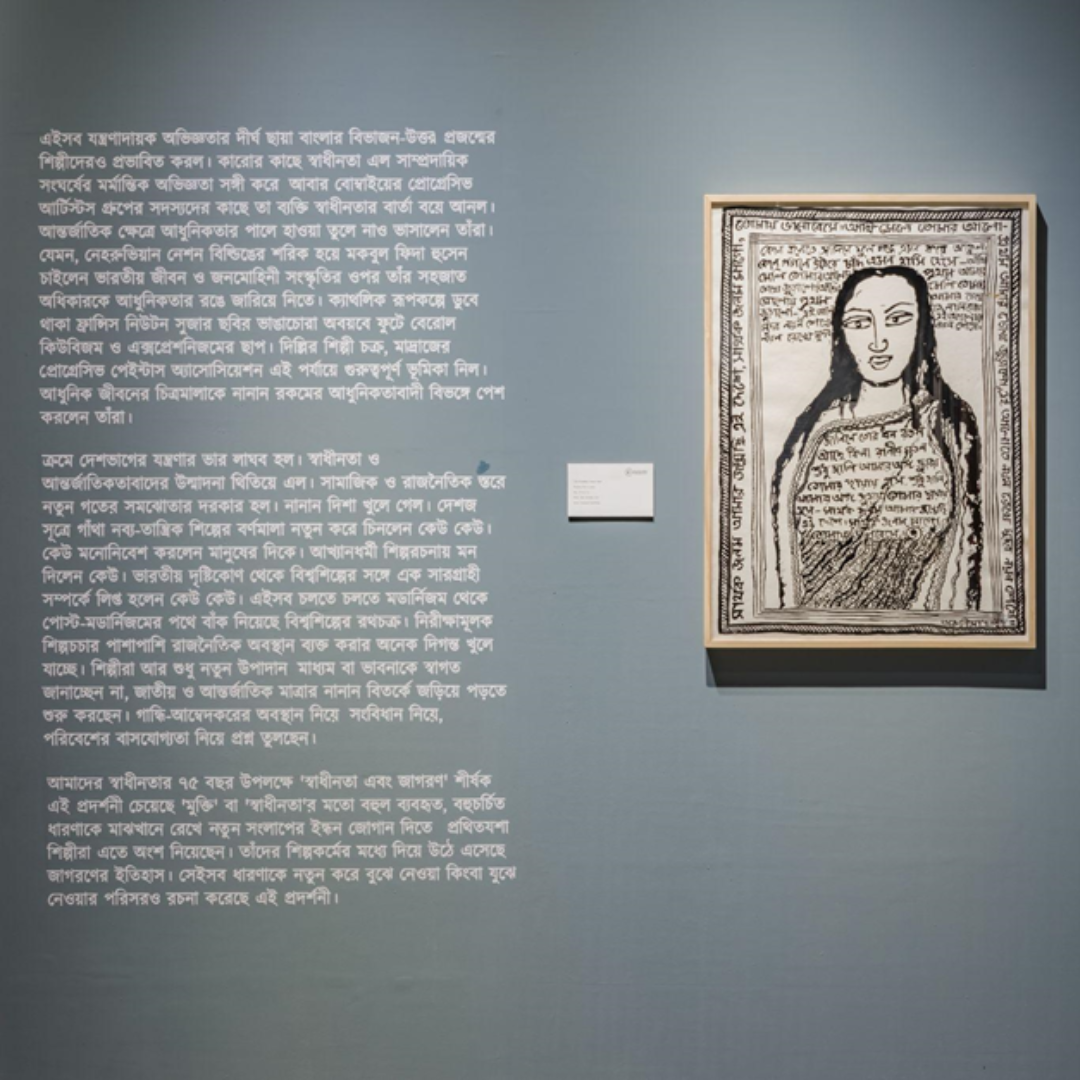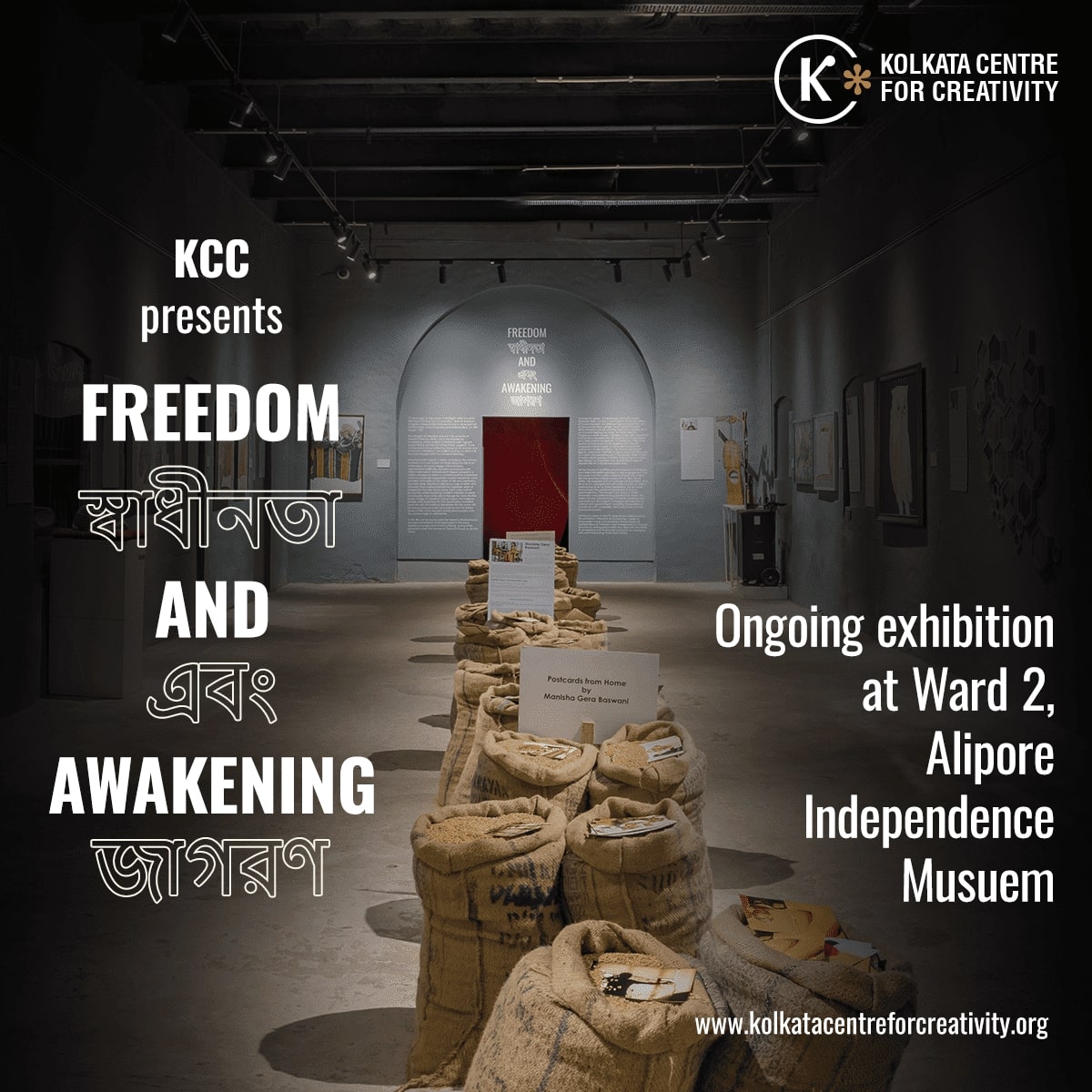Freedom and Awakening
To celebrate the opening of the Alipore Independence Museum, Kolkata Centre for Creativity (KCC) in collaboration with the Government of West Bengal has curated an exhibition titled ‘Freedom and Awakening’. This exhibition, which would be displayed in multiple phases, brings together prominent and promising artists from all over India to explore the ideas of freedom on the road to awakening. The foundational ideals that birthed India are intellectually probed and presented artistically.
In the words of Arunima Choudhury, “As an artist, I’m not expected to shout slogans like political parties. My protests are expressed on canvas or paper or through other art forms.” In a similar vein, Jogen Chowdhury’s painting that portrays a donkey-turned-leopard, a fantastic wild-beast, attacking with open claws and sneering teeth the very man that has put it on its back, seems like an oblique commentary on the contemporary political landscape of India. An image of a monstrous animal with lips pulled back, revealing sharp teeth, posited against dead bodies strewn in the background, can be seen in Chhatrapati Dutta’s artwork too, engaging one in a self-reflective dialogue on the recent times.

An abstract rendering of the ideas surrounding freedom and awakening can be seen in TV Santhosh and Jagannath Panda’s works. Tom J. Vattakuzhy’s reworking of Abanindranath Tagore’s Bharat Mata as a tribal woman draped in a distinctly gaudy pink saree unlike the saffron-coloured saree of the original figure evokes a plethora of thoughts and emotions. All the symbolic elements in the hands of Abanindranath’s Bharat Mata have been thrust together, what Tom calls the ‘objects of still life’, like a burden onto a basket placed atop her head. Adorned with tribal jewellery, with thick books on her head, Tom’s take of the iconic image of Bharat Mata is a powerful commentary on the society of today. Bholanath Rudra’s evocative watercolour painting depicting Gandhiji against a stark, dystopian background, is a vivid reminder of the state our country seems to be in to a large section of the population. The erasure of the ideologies upon which this country gained freedom — the ideologies of great freedom fighters like Gandhiji in present-day India, is reflected in Rudra’s work. A chilling image of Gandhiji standing alone at the helm against a world bereft of lofty ideals is sure to leave an imprint on all viewers.
According to Chandra Bhattacharjee, “Visuals have a habit of getting stuck to the brain. We should do more to use the magic of this medium to resuscitate our collective consciousness.” Through this medium, Manisha Gera Baswani evokes memories of the harshness that Freedom brought in its wake through Partition. Her exhibition, ‘Postcards from Home', which marks the 75th anniversary of India’s partition, will also be showcased as part of KCC’s exhibition. It features postcards of 47 artists from India and Pakistan, all with a shared history of the partition of India in 1947. Each postcard bears an image of a contemporary artist photographed by Baswani, while the reverse side of the card carries a poignant memory of that artist reminiscing the loss of ‘home’.

Visit the exhibition to view a range of artworks—from Indrapramit Roy’s Alipore Central Jail inspired artwork to contemporary ideals and illusions in the works of Soma Das and Santanu Debnath; from a comic take on freedom of speech and expression by Smarak Roy to Suman Chandra's artwork that seamlessly blends the visual quotes from Gaganendranath Tagore and Somnath Hore with his own artistic musings on the issue. Explore the thought processes of these artists and many more distinguished as well as up-and-coming artists through a range of works created based on the concept of ‘Freedom and Awakening’ on the occasion of 75th anniversary of India’s independence.
Concept Note
75 years ago, at the stroke of midnight, India became free from the clutches of coloniality. Years of freedom struggle, uncountable martyrdoms and a deep gash of Partition later, India finally became independent on 15th August 1947.
The struggle for freedom was not only a matter of freedom from the British, but it also implied an awakening. As the ending of Rabindranath Tagore’s poem ‘Where the Mind is Without Fear’ suggests, it was an expression of our collective aspiration to awaken into a heaven of freedom. The political journey to attain this freedom brought with it a cultural awakening.
Abanindranath Tagore is widely considered the primary architect of a new Indian art embodying the ideals of nationalism. His iconic image of Bharat Mata, appropriated politically, became synonymous with Indian nationalism. Rabindranath Tagore ushered in a holistic resurgence where a context-sensitive modernism came to challenge hegemonic western modernism and revivalist nationalism in the realm of arts and aesthetics. Nandalal Bose, Ramkinkar Baij and a crop of artists who followed them carried forward the Tagorean vision of modernism that did not shy away from cross-cultural encounters while remaining rooted in histories of place and people. Even as he did so through his works like the iconic image of Gandhi-ji’s Dandi March, the Haripura posters, and illustrations for the Constitution, Nandalal fused art with the political. Ramkinkar did the same with his monumental and radical sculptures like the Santal family (1938) which brought marginalised people onto the centre stage of national life.
In the 40s, just as young poets like Sukanta Bhattacharya shunned romanticism and responded to the harsh realities of hunger and human suffering, young artists gathered under the banner of Calcutta Group to do the same. Outside this group, Chittaprosad, and a little later Somnath Hore, carried it even further. The long shadow of these traumatic experiences also coloured the work of the post-partition generation of artists in Bengal. While freedom arrived with the traumatic experience of communal violence for some, for others like the Progressive Artists Group in Bombay it brought a moment of individual freedom and an opportunity to join forces with international modernism. For instance, while in the service of Nehruvian nation-building, M.F. Husain wrapped his knowledge of Indian life and popular culture in a modernist idiom, F.N. Souza's decadent figures, steeped in Catholic imagery, bore the influences of cubism and expressionism. In this phase, Shilpi Chakra in Delhi and Progressive Painter's Association in Madras also played an important role, combining images of modern life with myriad modernist styles.
As the trauma of partition and the euphoria of freedom and internationalism subsided, a new engagement with the social and the political began. It took many forms like the renewed indigenousness of the Neo Tantric artists, the engagement with people and narration, and an eclectic engagement with world art from an Indian perspective. Even as these happened, the art world moved from the period of modernism to that of postmodernism. This brought new issues of artistic innovation and political engagement into Indian Art. Artists not only adopted new materials, mediums and concepts but also began to engage with debates of national and global import, including the positions of Gandhi and B R Ambedkar, the Constitution and the lived environment.
On the occasion of the 75 years of our independence, this exhibition—Freedom & Awakening— seeks to encourage newer conversations around these oft-quoted ideas of ‘Freedom’ and ‘Independence’ through artworks by distinguished artists that deal with this history of awakening and finding self-expression by engaging with and interpreting these ideas afresh.
Come and experience the passage of history over these 75 years through the lenses of contemporary artists!
Prominent Artists featured:
Arunima Chowdhury
Chandra Bhattacharjee
Chhatrapati Dutta
Debanjan Roy
Debasish Mukherjee
Indrapramit Roy
Jagannath Panda
Jogen Chowdhury
Manisha Gera Baswani
Shipra Bhattacharya
Shuvaprasanna Bhattacharjee
Promising Artists featured:
Anjan Modak
Asif Imran
Bholanath Rudra
Deepak Poulose
Santanu Debnath
Sayantan Samanta
Soma Das
Smarak Roy
Suman Chandra
Suman Dey



